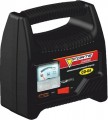Battery compatibility
The parameter determines
compatibility with batteries, that is, with what types of batteries a charger or start-charger or a car booster can be used. Incorrect charger operation mode promises overcharging of the battery, its swelling and failure.
WET / EFB (Lead-Acid). The abbreviation WET is used to designate traditional lead-acid batteries with a liquid electrolyte. EFB (Enhanced Flooded Battery) is their improved subtype with thicker pure lead plates and a positive electrode in a special microfiber envelope. Both transformer devices and most impulse batteries are suitable for charging acid batteries.
AGM. In the design of AGM batteries, the electrolyte is in an absorbed state: the compartments of such a battery are filled with porous fiberglass material, which contains acid. This type of battery is particularly sensitive to overcharging - it is necessary to select a suitable charger with a certain set of automatic functions for it.
gel. In gel batteries, the electrolyte is brought to a jelly-like state with the help of special thickeners. The key to choosing the right GEL battery charger is the ability to vary the amount of charging current depending on how badly the battery is discharged.
LifePO4. Lithium iron phosphate batteries are charged with constant voltage an
...d current. As the voltage in the battery approaches the maximum value, the charge current should decrease, and after the end of the charging process, its supply should stop completely. To keep LiFePO4 batteries in good shape, devices with appropriate automatic functions are suitable.
Li-Ion. Lithium-ion Li-Ion batteries are charged in the same way as lithium-iron-phosphate counterparts. For them, you will need to pick up an automatic device with the ability to supply constant voltage and current.Battery voltage
The nominal voltage of the batteries that the device can work with. For boosters (see "Type"), in this case, the voltage that the "starter" can output at the output in the engine start mode is indicated.
-
6 V. Voltage found in some motorcycles, scooters, ATVs and similar vehicles.
-
12 V. Standard voltage of batteries (and on-board networks) for passenger cars, as well as light trucks and minibuses.
-
24 V. Voltage used mainly in trucks, buses and other heavy equipment. Also found in some heavy SUVs.
Max. charging current
The highest current that the charger can provide in charging mode. For models with one current adjustment (see below), its value is also indicated in this paragraph.
Different battery models may differ in charging parameters, including over the optimum current range. Accordingly, it is worth choosing a charger in such a way that it matches this range. Detailed selection recommendations can be found in special sources — in particular, documentation for batteries.
Current adjustment
The number of adjustments (fixed settings) of the current strength provided in the design of the charging device.
One adjustment means that the device is capable of delivering a
strictly fixed current. And if there
are several adjustments, then the more there are, the more accurately you can adjust the operating parameters for a specific battery, the less likely it is that the optimal current value will fall between two adjustments.
In addition, there are two specific types of adjustment —
automatic and
smooth. Smooth adjustment allows you to select almost any value of current strength within the adjustment range; in this case, the tuning accuracy can reach tenths or even hundredths of an ampere. On the other hand, such an adjustment is the most demanding on the knowledge and skills of the user: you need to know exactly the parameters of the battery being charged and strictly monitor the observance of the charging mode. The opposite option is automatic adjustment — when the charger independently determines and sets the required current value. This option is as convenient and simple as possible — only some basic settings may be required from the user, for example, specifying the type of battery being charged. At the same time, in some models, automation can not only initially set the optimal current strength, but also
...regulate it during the charging process depending on the state of the battery, providing the most efficient and gentle charging mode.Battery capacity 12V
The capacity of batteries with an operating voltage of 12 V, for which a starter charger can be used. As a rule, modern units are not designed for one specific value, but for a range of capacities, which greatly facilitates the search filter according to the required parameters.
Note that although the discrepancy between the rechargeable battery in terms of capacity is not as critical as in terms of current or voltage, this does not mean that this parameter should not be paid attention to. Both too capacious and too “small” a battery will cause the charger to work in an off-design mode, which is harmful to both the “charger” and the battery, and can even lead to accidents.

